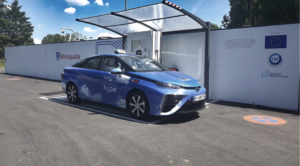Climate change is widely recognized as one of the most serious challenges to the nature, as well as to economic and energy security. In 2020, 22 distinct billion-dollar weather and climate disasters were reported across the United States. Repairing infrastructure and other damage caused by flooding, drought, heat, cold, hurricanes, and other extreme weather, as well as reviving power to the electric grid following outages caused by weather, is becoming far too dangerous and expensive to neglect any longer.
The realization that decarbonization is vital to achieve the necessary emissions reductions to prevent these calamities has grown starker in the five years since the Paris Climate Accord was introduced at the United Nations (UN) Climate Change Conference of the Parties (COP). Thousands of leaders, delegates, stakeholders, and activists from around the world will gather in Glasgow, Scotland, for COP 26 to build on that historic agreement and propose practical solutions to address climate change before it is too late.
Hydrogen energy and fuel cell technology have emerged as important tools in the mitigation of climate change. Both are not new to the energy arena, but they are currently being praised as essential components in the reduction of carbon emissions across a variety of market sectors. Hydrogen is likely to play a major part in conversations and strategies at the COP 26 conference on how to accomplish any goals that have been or will be set.
Hydrogen can be synthesized from a range of low- and zero-carbon feedstocks and technologies, such as solar or wind-powered electrolysis, biogas or waste gas, nuclear power, or other low-carbon sources like natural gas with carbon capture and sequestration. Its allure stems from its adaptability, which allows hydrogen to be generated using localized resources and pathways.
For climate experts, green or renewable hydrogen made from the electrolysis of water powered by solar or wind is indispensable to climate neutrality. It features in all eight of the European Commission’s net zero emissions scenarios for 2050 . In theory, it can do three things: store surplus renewables power when the grid cannot absorb it, help decarbonize hard-to-electrify sectors such as long-distance transport and heavy industry and replace fossil fuels as a zero-carbon feedstock in chemicals and fuel production.
The EU’s post-COVID-19 economic recovery package4 prioritizes the hydrogen economy; this package is governed by the European Green Deal, which commits Europe to being the world’s first climate-neutral continent by 2050. It’s difficult to emphasize the difference between this and Europe’s previous aim of reducing emissions by 80 to 95 percent by 2050. To achieve net-zero energy, all fossil fuels must be phased out completely. For the first time, it puts the spotlight on gas. For a new lease on life, the gas industry is looking to hydrogen.
The climate community, on the other hand, is skeptical.
“The risk is that the (hydrogen) hype causes a reversal of priorities,”
says Dries Acke, head of the energy program at the European Climate Foundation, a philanthropic initiative aimed at accelerating the transition to a climate-neutral economy based in Brussels. “The major solutions (to changing climate) are energy efficiency, renewables, and direct electrification.” Around this time, hydrogen comes in to play. Hydrogen is necessary to reach net zero in some sectors, such as industry, but we’re only talking about the final 20% of emissions reductions.
Regulation is necessary for the development of a clean hydrogen economy. The most difficult task is putting in place the appropriate policies. It’s critical to have a hydrogen infrastructure. That is a massive undertaking that will require political support. The first-ever European hydrogen plan, published in July 2020, aims to help achieve the greater goal of “sector integration. Originally, this meant utilizing carbon-free energy to assist in the decarbonization of other sectors such as transportation and industry. However, it has developed into a larger attempt to define the roles of electricity and “molecules” in the future energy system.
Another aspect of industry is that Europe is the world leader in electrolysis technology. Over the previous 10 to 15 years, it has filed roughly twice as many patents and publications as its closest competitors the United States, China, and Japan. Electrolyzer, like solar, wind, and batteries, will become key technology. Europe has and will continue to have a competitive advantage. Nonetheless, others are already predicting fierce competition from China.
The green hydrogen economy requires specific assistance. The EU’s program is attempting to replicate the renewable energy industry’s success. However, unlike solar and wind, green hydrogen generation is driven by operational expenditure rather than capital cost. The cost of power accounts for 80% of the total. Incentives to encourage large-scale deployment may lower the cost of electrolyzers, but this does not necessarily lower the cost of green hydrogen production.
Green hydrogen’s major challenge is that it will require a lot of renewable energy. According to the International Energy Agency, satisfying today’s hydrogen demand with water electrolysis would require 3,600 TWh per year, which is equivalent to the EU’s whole annual electricity production. Consider how it could be used as an energy carrier in manufacturing, transportation, heating, and power generation.
One of the most pressing concerns is whether enough green hydrogen can be produced quickly enough to make an impact in the fight against climate change. “We live within the constraints of carbon budgets,” Niessen argues. Electrolysers are not the same as microchips. Costs will undoubtedly decrease, but will they do so quickly enough to reach the Paris climate goals?
Many people feel that blue hydrogen can play a transitional role if it is used with suitable climate precautions. It could help to kick-start various sectoral usage while also lowering prices due to economies of scale.
If significant decarbonization is a priority for society, hydrogen will emerge. It is not a question of thermodynamic laws, but rather of society’s willingness to pay for climate neutrality.




